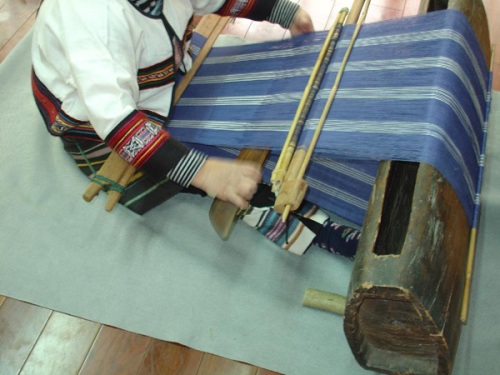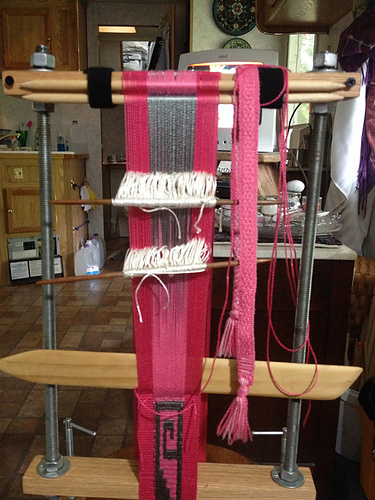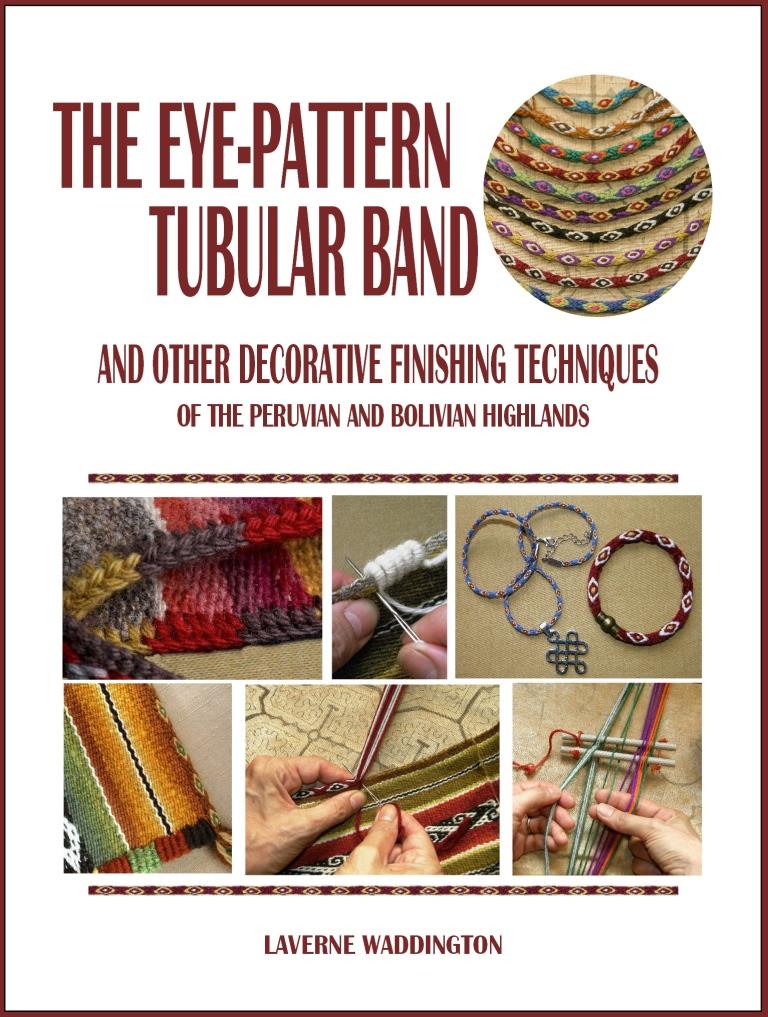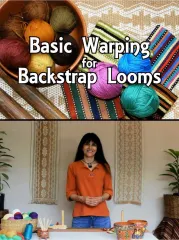I got distracted again this week. I love getting distracted. It’s always good and it’s almost always related to weaving. Between the delightful distraction and a lot of warping, I did manage to find some time to spend at my loom…
 I ended the brocaded part with seven little stepped peaks and will now weave the rest as seven separate brocaded tabs. I am doing this because I want this panel to match the central panel of my Shipibo-inspired piece which also ends with seven woven strips. The other end will have a weft-twined pattern, probably something that is based on those stepped peaks.
I ended the brocaded part with seven little stepped peaks and will now weave the rest as seven separate brocaded tabs. I am doing this because I want this panel to match the central panel of my Shipibo-inspired piece which also ends with seven woven strips. The other end will have a weft-twined pattern, probably something that is based on those stepped peaks.
Now, about that distraction…
All of you who have Facebook accounts will know the feeling when you receive a friend request from someone whose name you do not recognize….do I actually know this person, are they a friend of friend, what is the possible connection, is this just someone who likes to collect friends? I take a look at their page to see if there’s any weaving or fibery content and look for mutual contacts. Very rarely, the person who sent the request will also send a message. In case you didn’t know, there is a message inbox entitled “other” in the message section of your account to which people who are not your Facebook friends can send messages. Facebook does not send notifications for these and you have to go and look for them yourself. When I was first told about this inbox, I found a pile-up of messages dating back to 2010!…ex-boyfriend, old neighbors, requests to meet and weave with me!
Anyway…Yen-Chi Sun sent me a message. Yen-Chi Sun tells me that he is Taiwanese and that he is working with others to revive, document, and re-learn traditional backstrap weaving techniques. He had found my blog and thought that I might be interested in what he is doing :-). He shared pictures which he has allowed me to show here.
 The language barrier makes our communication brief and a little disjointed but, from what I gather, Yen-Chi Sun’s group has been studying textiles in museum collections as well as discussing and observing techiques with elderly people who are still weaving in the places where these practices originated.
The language barrier makes our communication brief and a little disjointed but, from what I gather, Yen-Chi Sun’s group has been studying textiles in museum collections as well as discussing and observing techiques with elderly people who are still weaving in the places where these practices originated.
What a fabulous sight to see in the picture above…all those young people learning to use the newly-built versions of the traditional loom with its unusual tipping footbrace box (what else am I to call that thing!) You can see how the man in the picture is relaxing tension on the warp so that he can open the heddle shed. He does so by moving his feet and allowing the box to tip forward.
This next picture shows warping in progress in what Yen-Chi Sun calls the “five columns warping method”. Heddles are applied, as they are in many places in Asia and Southeast Asia, while the warp is being wound.
 I love those sturdy forked sticks used as the cross posts and end stake. I am not sure why the end stake is also forked but I think it might have something to do with the placement of threads for the coil rod…just my guess. My Montagnard weaving teachers have a stake in their warping set-up that creates the space for the coil rod. You can see the coil rod as it sits in the warp behind the box on the red warp in the above picture.
I love those sturdy forked sticks used as the cross posts and end stake. I am not sure why the end stake is also forked but I think it might have something to do with the placement of threads for the coil rod…just my guess. My Montagnard weaving teachers have a stake in their warping set-up that creates the space for the coil rod. You can see the coil rod as it sits in the warp behind the box on the red warp in the above picture.
 I have created a few circular warps myself, like the one at left, and was surprised while weaving on them to find that I had a definite urge to have my feet braced against something, much more so than when I weave a piece that has been warped in a single plane. I love how the foot brace in the traditional Atayal loom of Taiwan can be used not only to help the weaver apply tension the warp but also to allow the weaver to relax tension.
I have created a few circular warps myself, like the one at left, and was surprised while weaving on them to find that I had a definite urge to have my feet braced against something, much more so than when I weave a piece that has been warped in a single plane. I love how the foot brace in the traditional Atayal loom of Taiwan can be used not only to help the weaver apply tension the warp but also to allow the weaver to relax tension.
Yen-Chi Sun also sent me the following picture from a demonstration in which the parts of the loom have been labeled (unfortunately for us, in Chinese) and so I will have to keep using silly names of my own invention like “tipping footbrace box”.
The following video is wonderful. All the speaking is in Chinese but. honestly, it doesn’t matter. The observers are asking questions about all the things that I would want to know and you can tell exactly what is going on. It is a delight! Watch that fancy footwork!
The webpage of Taiwan Pictures Digital Archives has many old images of weavers and spinners in Formosa at work like the one below:
John G Kreifeldt, whom I met recently online because of his interest in Asian art, allowed me to show a picture he took of an Atayal woman weaving during one of his visits to Taiwan.
 Here you can very clearly see the shed rod (with which I am in love!) Those of you who use a pair of sticks or a forked stick in a second cross in your backstrap warp which you grasp and twist to help open the heddle shed, will understand immediately what is going on with that stick. I put together something similar in my ikat piece right now so that I could try it out. But, more about that next week…
Here you can very clearly see the shed rod (with which I am in love!) Those of you who use a pair of sticks or a forked stick in a second cross in your backstrap warp which you grasp and twist to help open the heddle shed, will understand immediately what is going on with that stick. I put together something similar in my ikat piece right now so that I could try it out. But, more about that next week…
As for the kinds of textiles that are produced by these weavers and their traditional uses, I am trying to gather information about that for a future blog post.
 About that fancy footwork…when I think about it, I have been using similar foot movements to operate warps that I attach to my big toe, that is, a movement which relaxes the tension on the warp. I found that while I was weaving with such a set-up, rather than moving forward to relax the tension on the warp, I would simply flex my foot. It was done unconsciously and was such a natural and logical movement.
About that fancy footwork…when I think about it, I have been using similar foot movements to operate warps that I attach to my big toe, that is, a movement which relaxes the tension on the warp. I found that while I was weaving with such a set-up, rather than moving forward to relax the tension on the warp, I would simply flex my foot. It was done unconsciously and was such a natural and logical movement.
Now, I am not saying that tipping and controlling that big and heavy looking box with one’s feet is natural and easy. I imagine that the feet must go through a long period of training to get to the point where they can manage the moves well.
Which is precisely what Tracy Hudson told me when I asked her to describe her experience weaving in Laos with looms that require some fancy footwork.
In Tracy’s words:
 One photo shows me using Keo’s loom. My feet are flexed to release tension as I open the heddle shed, holding a bar wrapped behind the other shed sticks to assist the process.
One photo shows me using Keo’s loom. My feet are flexed to release tension as I open the heddle shed, holding a bar wrapped behind the other shed sticks to assist the process.
From Betsy Renfrew’s webpage backstrapweavers.blogspot.com


































Thank you, Laverne, for another wonderful account. I look forward to your blog popping into my inbox on Fridays, so informative and interesting.
By: Ann Littlewood on August 29, 2014
at 10:21 am
Very interesting article, Laverne, as always. Something new to try…..
By: Connie on August 29, 2014
at 2:57 pm
Nuestros pies, benditos pies…y para tí, un abrazo fuerte por permitirnos ver tanta belleza dispersa en el mundo.
By: RUTH on August 31, 2014
at 1:50 pm
So fascinating. I love learning about different backstrap set-ups. Would love to have some building plans for the Japanese/ Korean style backstrap loom! Look forward to your next post on the Atayal shed rod…
By: Kristin on September 2, 2014
at 11:00 pm
I love the tipping foot brace box. It looks very comfortable, if that’s the right word. It looks like it would feel good on the feet and stretching the calves. It even looks like it has storage inside for keep the loom parts when not in use.
By: BWeaves on September 3, 2014
at 3:33 pm
Mon, another Katu weaver at Ock Pop Tok, flips the 2 bamboo poles over each other from time to time. I thought I had a video of this to share with you, but have found that none of the ones I have uploaded to Youtube include this. I think I remember that she did this after she had changed the shed. Maybe it was a way to tighten any warp threads that were loosening slightly? I must ask her next time I see her.
By: Textile Trails on September 4, 2014
at 11:50 pm